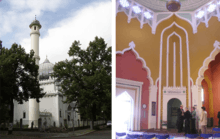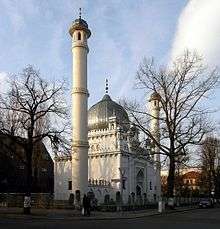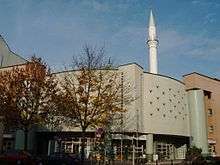Berlin Mosque
Berlin Mosque (German: Berliner Moschee, Wilmersdorfer Moschee, Ahmadiyya Moschee) in Berlin is situated on Brienner Straße 7-8 in Berlin-Wilmersdorf. It was designed by K. A. Hermann and was built between 1923 and 1925. Berlin Mosque, which has two 90 feet (27 m) tall minarets, was heavily damaged in World War II. The two minarets were rebuilt in 1999/2001.
.jpg)
| Wilmersdorfer Moschee Berlin Mosque | |
|---|---|
 Exterior (left) and interior (right) of the mosque | |
| Religion | |
| Affiliation | Ahmadiyya |
| Location | |
| Location | |
| Administration | Lahore Ahmadiyya Movement for the Propagation of Islam |
| Geographic coordinates | 52.4875°N 13.311667°E |
| Architecture | |
| Architect(s) | K. A. Hermann |
| Style | Modern Indo-Islamic |
| Completed | 1925 |
| Specifications | |
| Capacity | 400 |
| Dome(s) | 1 |
| Dome height (outer) | 26 meters (85 ft) |
| Dome dia. (outer) | 23 meters (75 ft) |
| Minaret(s) | 2 |
| Minaret height | 27.5 meters (90 ft) |
| Website | |
| berlin.ahmadiyya.org/ | |
The foundation stone was laid on 6 August 1923 [1] and the mosque was inaugurated officially on 26 April 1925.[2]
The style of the space is built in Mughal Architectural style, reflecting the great buildings of that time with signature stylings. One such styling is the architects use of onion dome and pastel colors.[3] This makes the building very similar to the tombs of the Mughal Empire. Not only that, but the symmetry seen in the building reflects that of the Taj Mahal. Next to the mosque is the residence of the Imam, the religious head of the mosque. The Imam's residence stands at two stories tall.[4]

The mosque is owned and maintained by the Lahore Ahmadiyya Movement (Ahmadiyya Anjuman Isha'at-i-Islam Lahore).
History
Due to the small influence Islam had in Germany prior to the building of the mosque in the 1900s, the Berlin Mosque was preceded by a small wooden structure built outside of Berlin, which was destroyed in 1923.[5] Not long after, the Lahore Ahmadiyya Movement, who saw the need to construct a mosque in Germany, did so. The Berlin Mosque's tall minarets were heavily damaged in World War II due to an attack by Russian soldiers. Not only were the minarets damaged but the dome received damage as well. After receiving funds from the Berlin Monuments Department to restore the building, the mosque was able to be reopened in 1952.
References
- Berlin im Jahr 1923
- Die Berliner Moschee und Mission der Ahmadiyya-Bewegung zur Verbreitung des Islam (Lahore), S. 12f.
- Rizvi, Kishwar (2015). The transnational mosque : architecture and historical memory in the contemporary Middle East. Chapel Hill. ISBN 978-1-4696-2495-2. OCLC 923254240.
- "Reports of renovation work at the Berlin Mosque". www.muslim.org. Retrieved 9 December 2019.
- Jonker, Gerdien (November 2005). "The Mevlana Mosque in Berlin-Kreuzberg: An Unsolved Conflict". Journal of Ethnic and Migration Studies. 31 (6): 1067–1081. doi:10.1080/13691830500282683. ISSN 1369-183X.
Further reading
- Nath, R. (Ram), 1933- (1982-<2005>). History of Mughal architecture. New Delhi: Abhinav. ISBN 0-391-02650-X. OCLC 9944798.
- Religious architecture : anthropological perspectives. Verkaaik, Oskar,. Amsterdam: Amsterdam University Press. 2013. ISBN 978-90-485-1834-0. OCLC 869720783.
- Jonker, Gerdien (2019). "Das Moscheearchiv in Berlin-Wilmersdorf: Zwischen muslimischer Moderne und deutscher Lebensreform". In MIDA Archival Reflexicon, pp. 1-10.
External links
- Ahmadiyya Mosque at Structurae
- The Berlin Mosque on the official website Berlin.de: http://www.berlin.de/ba-charlottenburg-wilmersdorf/bezirk/lexikon/islamischemoschee.html

